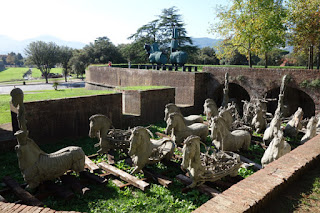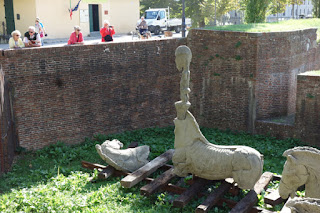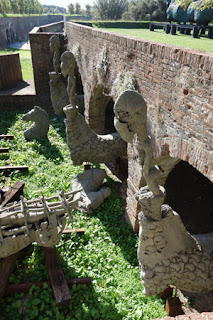Dear Art Lover,
I found myself in Lucca, Italy,
recently, at the invitation of a new friend.
As the bus entered the station at Piazza
Verdi, I saw the heads of horses.
They were sculptures and I was intrigued. Knowing that I was early, I decided to wander
over to have a look. So glad that I did…
and later, I even brought my friend over.
Mexican
sculptor Gustavo Aceves has created two massive sculpture works [one a single piece; the other an amazing parade]
that is temporarily on exhibit in Lucca [I never saw for how long]. It is titled “Lapidarium,” although the
only sign about the work implies the title is “Passo Sospeso” [Suspended
Step] I will write about the large bronze horse in the next post. This post is about the grouping of fifteen
horses [the sign says, count if you like] that are exhibited “within” the
famous wall around Lucca,
in what appears to be a sunken area with arches. My friend explained that the water and aqueducts
passed by those arches behind this sculpture installation.
I quote part of the sign for this sculpture
grouping [I rewrote a little to correct the poor translation to English]:
These sculptures represent a
sort of “monument to the vanquished,” a metaphor of the unceasing migration process over thousands of years. Part of a larger group, these sculptures
travel along to many important sites around the world, such as Brandenburg Gate
in Berlin, and an archeological area in Rome (Mercati di Traiano, l’Arco di Costantino e la Piazza del Colosseo). After this exhibition leaves Lucca,
Italy, it will travel on to
the Acropolis in Athens, Beijing,
and Paris. In 2019 it will arrive in Mexico, the
birthplace of the author.
 |
| the gate aids the impact of the message, no? |
 The artist has obviously used
the same mold to create the horses, the male African-inspired figures that
stand atop some of the horses, and I think even the grouping of skulls that
line the torsos of the three horses in the rear of the “parade.” Repetition is a common compositional
device. It gives us a feeling of calm,
continuity, cohesion of the separate items as a whole, and sometimes
security. Our brain catches onto the
pattern and completes and continues it, feeling good about the order of
things. However, too much repetition creates
boredom, precisely for the reason that the brain knows what to expect and needs
not look further. In a large sculpture,
such as this grouping, it makes economic sense for the artist to do this as
well.
The artist has obviously used
the same mold to create the horses, the male African-inspired figures that
stand atop some of the horses, and I think even the grouping of skulls that
line the torsos of the three horses in the rear of the “parade.” Repetition is a common compositional
device. It gives us a feeling of calm,
continuity, cohesion of the separate items as a whole, and sometimes
security. Our brain catches onto the
pattern and completes and continues it, feeling good about the order of
things. However, too much repetition creates
boredom, precisely for the reason that the brain knows what to expect and needs
not look further. In a large sculpture,
such as this grouping, it makes economic sense for the artist to do this as
well.
 |
| Repetition and Variety |
 |
| One feels the exhaustion and struggle, yet anticipation [standing figures] |
 |
| My apologies for the dark spot in the upper left white on the wall-need a new camera. |
 |
| Bus Station at Piazza Verdi is off to the left - wall of Lucca, Italy |
 |
| Even the holes on the neck of the fallen horses are repetition |
That said, the artist Gustavo Aceves, has then used other compositional means to break up
this repetition. Each horse is different
in content. Some have been cropped, with
only the neck and heads positioned as some of the fallen during the great
migration. The horses still walking are
positioned in slightly different angles to imply movement and individuality within
the group. But more importantly, and
visually and intellectually stimulating, the bodies of the horses are unique. Some of the bodies have
wooden sticks and even masts or crosses, implying migration by ship. One shows the famine in the exposed rib cage
of a horse. Some of the horses have
large stitching across a leg or a face to imply how the journey wounds and yet,
the march continues. Others have human
figures tied to wooden sticks, depicting slavery. There is one horse that carries the load of
horses hooves inside his back/wagon.
 |
| The train tracks were another reinforcing visual to the idea |
 |
| Powerfully conceived work of public art! |
 |
| little suspended bodies are tied up inside of this horse |
 |
| A much larger proportioned human corpse rests inside the horse on the right |
 |
| Horse hooves must be a thing of value, or perhaps they were shoes/metal? |
Then there are the three
figures in the back, obviously made from the same mold as the figure up front,
but each individualized with netting and other small details. They stand upon the necks of headless
horses. The bodies of the horses are
made up of many skulls. The visual language makes
an obvious and clear heavy statement and yet the figures are beautiful at the same
time. The materials were not listed for
this artwork but the surface texture looks like sand. There are parts of horses’ faces that imply
ceramic, although I think it was more likely colored or painted resin.
 |
| Do the African figures represent people or more like mast fronts on a ship? |
 |
| Three horse bodies at the rear are made up of human skulls. |
An exhibition of this size is
expensive to transport and to install. However,
I loved this work and the placement of it in Lucca.
I am curious how the same sculpture grouping looked and will look in the
other cities along this tour. If you
happen to see it anywhere else, please share your images of it with me.
Enjoy.. I hope not too many
photos!
Peace,
Kelly Borsheim, artist
P.S. IF original art, while
affordable, is STILL a bit out of your budget, or the piece you adored has
sold? Or do you like arty things in
different formats, to surround yourself with art? Looking for a gift? See my store online for pillow, phone cases,
shower curtains, towels, tote bags, and yes, even prints on metal, wood,
canvas, and so much more:
 |
| View from the gate at the bottom |
 |
| Imagine the quality of images from a GOOD camera! |

 The artist has obviously used
the same mold to create the horses, the male African-inspired figures that
stand atop some of the horses, and I think even the grouping of skulls that
line the torsos of the three horses in the rear of the “parade.” Repetition is a common compositional
device. It gives us a feeling of calm,
continuity, cohesion of the separate items as a whole, and sometimes
security. Our brain catches onto the
pattern and completes and continues it, feeling good about the order of
things. However, too much repetition creates
boredom, precisely for the reason that the brain knows what to expect and needs
not look further. In a large sculpture,
such as this grouping, it makes economic sense for the artist to do this as
well.
The artist has obviously used
the same mold to create the horses, the male African-inspired figures that
stand atop some of the horses, and I think even the grouping of skulls that
line the torsos of the three horses in the rear of the “parade.” Repetition is a common compositional
device. It gives us a feeling of calm,
continuity, cohesion of the separate items as a whole, and sometimes
security. Our brain catches onto the
pattern and completes and continues it, feeling good about the order of
things. However, too much repetition creates
boredom, precisely for the reason that the brain knows what to expect and needs
not look further. In a large sculpture,
such as this grouping, it makes economic sense for the artist to do this as
well. 




















No comments:
Post a Comment